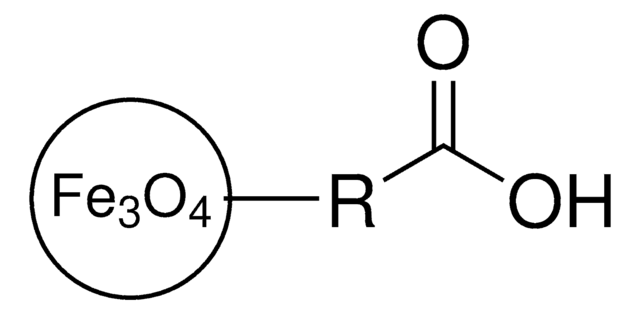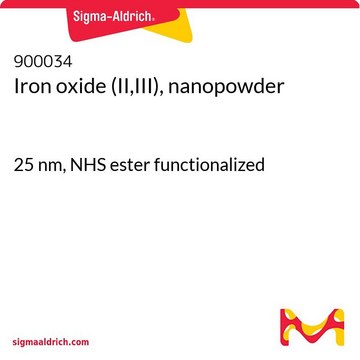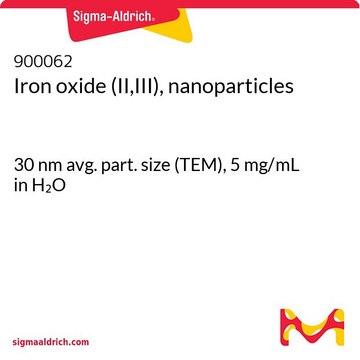747467
Iron oxide(II,III) magnetic nanopowder
30 nm avg. part. size (TEM), NHS ester functionalized
Sinónimos:
Fe NP NHS, FexOy
About This Item
Productos recomendados
form
nanopowder
powder
composition
Fe, ~1.25 % (w/w)
magnetization
>45 emu/g, at room temperature; under 4500 Oe
color
light brown to dark brown, and Dark Grey
avg. part. size
30 nm (TEM)
functional group
NHS ester (functionalized)
storage temp.
−20°C
¿Está buscando productos similares? Visita Guía de comparación de productos
Application
Legal Information
Storage Class
11 - Combustible Solids
wgk_germany
WGK 2
flash_point_f
Not applicable
flash_point_c
Not applicable
Elija entre una de las versiones más recientes:
¿Ya tiene este producto?
Encuentre la documentación para los productos que ha comprado recientemente en la Biblioteca de documentos.
Los clientes también vieron
Artículos
Iron oxide (IO) nanoparticles consist of maghemite (γ-Fe2O3) and/or magnetite (Fe3O4) particles with diameters ranging from 1 and 100 nanometer and find applications in magnetic data storage, biosensing, drug-delivery etc.
The recent emergence of a number of highly functional nanomaterials has enabled new approaches to the understanding, diagnosis, and treatment of cancer.
Professor Yadong Yin (University of California Riverside, USA) examines both direct (thermal decomposition, solvothermal, hydrothermal) and indirect (templated) synthesis methods of magnetite nanocrystals and reviews in detail the landscape of these various synthetic methods for magnetite nanocrystal and their applications in magnetic assembly, magnetic hyperthermia, and Li-Ion batteries.
Biomaterials science involves the design and fabrication of smart materials for studying, directing, or mimicking biology. For successful integration of biomaterials in biological research, a meaningful understanding of biological systems is required.
Nuestro equipo de científicos tiene experiencia en todas las áreas de investigación: Ciencias de la vida, Ciencia de los materiales, Síntesis química, Cromatografía, Analítica y muchas otras.
Póngase en contacto con el Servicio técnico





